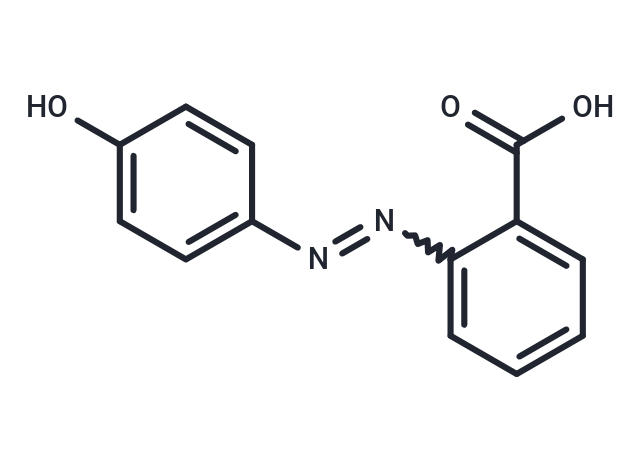Shopping Cart
Remove All Your shopping cart is currently empty
Your shopping cart is currently empty
2-(4-Hydroxyphenylazo)benzoicacid is a spectrophotometric probe that shows changes in absorption spectra upon binding to proteins and binds to bovine serum proteins.

| Pack Size | Price | USA Warehouse | Global Warehouse | Quantity |
|---|---|---|---|---|
| 500 mg | $37 | - | In Stock | |
| 1 g | $50 | - | In Stock | |
| 2 g | $70 | - | In Stock |
| Description | 2-(4-Hydroxyphenylazo)benzoicacid is a spectrophotometric probe that shows changes in absorption spectra upon binding to proteins and binds to bovine serum proteins. |
| In vitro | Instructions 1. Storage solution preparation: When preparing the stock solution, deionized water or an appropriate amount of ethanol can be used, and the concentration range is usually 1–10 mM. 2. Operation steps: Binding experiment: 1. Binding of protein and probe: 1) Dissolve the target protein (such as bovine serum albumin, BSA) in an appropriate buffer (such as PBS buffer at pH 7.4). 2) Add 2-(4-Hydroxyphenylazo)benzoic Acid in a certain proportion to ensure that its final concentration is suitable for absorption spectrum measurement (such as 10–50 µM). 2. Incubation conditions: Incubate the mixed system at room temperature or 37°C for 10–30 minutes to ensure that the probe is fully bound to the protein. 3. Absorption spectrum detection: Use a spectrophotometer to scan the absorption spectrum changes in the range of 350–500 nm. After the probe binds to the protein, its characteristic absorption peak (usually around 400 nm) will change significantly. 4. Data analysis: Compare the absorption spectra of the free probe after binding to the protein to determine the binding kinetic parameters. Use titration experiments (such as gradually increasing the probe or protein concentration) to draw binding curves and calculate the binding constant. Notes: 1) The probe is sensitive to pH and a suitable buffer should be used to stabilize the experimental conditions. 2) Prevent light from causing compound degradation or protein denaturation. 3) Before the measurement, ensure that the solution is free of bubbles and particles to avoid interfering with spectral detection. |
| Molecular Weight | 242.23 |
| Formula | C13H10N2O3 |
| Cas No. | 1634-82-8 |
| Smiles | OC(=O)c1ccccc1N=Nc1ccc(O)cc1 |
| Storage | keep away from direct sunlight | Powder: -20°C for 3 years | In solvent: -80°C for 1 year | Shipping with blue ice/Shipping at ambient temperature. | ||||||||||||||||||||||||||||||
| Solubility Information | Ethanol: 18 mg/mL (74.31 mM), Sonication is recommended. | ||||||||||||||||||||||||||||||
Solution Preparation Table | |||||||||||||||||||||||||||||||
Ethanol
| |||||||||||||||||||||||||||||||
| Size | Quantity | Unit Price | Amount | Operation |
|---|

Copyright © 2015-2025 TargetMol Chemicals Inc. All Rights Reserved.